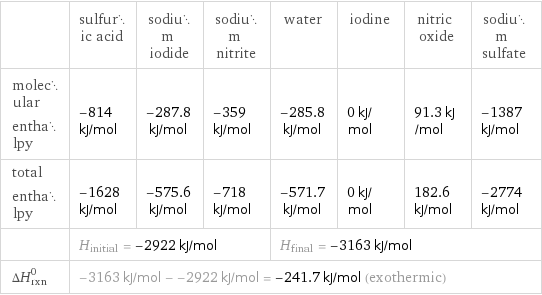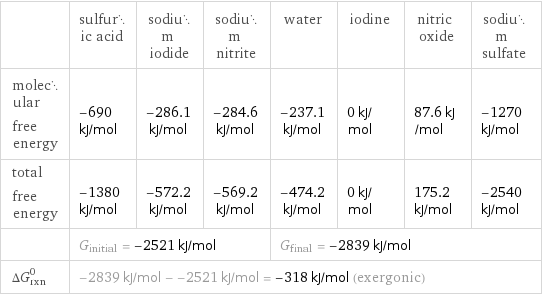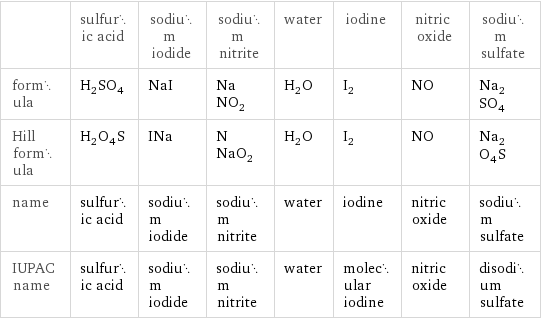Input interpretation

H_2SO_4 (sulfuric acid) + NaI (sodium iodide) + NaNO_2 (sodium nitrite) ⟶ H_2O (water) + I_2 (iodine) + NO (nitric oxide) + Na_2SO_4 (sodium sulfate)
Balanced equation

Balance the chemical equation algebraically: H_2SO_4 + NaI + NaNO_2 ⟶ H_2O + I_2 + NO + Na_2SO_4 Add stoichiometric coefficients, c_i, to the reactants and products: c_1 H_2SO_4 + c_2 NaI + c_3 NaNO_2 ⟶ c_4 H_2O + c_5 I_2 + c_6 NO + c_7 Na_2SO_4 Set the number of atoms in the reactants equal to the number of atoms in the products for H, O, S, I, Na and N: H: | 2 c_1 = 2 c_4 O: | 4 c_1 + 2 c_3 = c_4 + c_6 + 4 c_7 S: | c_1 = c_7 I: | c_2 = 2 c_5 Na: | c_2 + c_3 = 2 c_7 N: | c_3 = c_6 Since the coefficients are relative quantities and underdetermined, choose a coefficient to set arbitrarily. To keep the coefficients small, the arbitrary value is ordinarily one. For instance, set c_5 = 1 and solve the system of equations for the remaining coefficients: c_1 = 2 c_2 = 2 c_3 = 2 c_4 = 2 c_5 = 1 c_6 = 2 c_7 = 2 Substitute the coefficients into the chemical reaction to obtain the balanced equation: Answer: | | 2 H_2SO_4 + 2 NaI + 2 NaNO_2 ⟶ 2 H_2O + I_2 + 2 NO + 2 Na_2SO_4
Structures

+ + ⟶ + + +
Names

sulfuric acid + sodium iodide + sodium nitrite ⟶ water + iodine + nitric oxide + sodium sulfate
Reaction thermodynamics
Enthalpy

| sulfuric acid | sodium iodide | sodium nitrite | water | iodine | nitric oxide | sodium sulfate molecular enthalpy | -814 kJ/mol | -287.8 kJ/mol | -359 kJ/mol | -285.8 kJ/mol | 0 kJ/mol | 91.3 kJ/mol | -1387 kJ/mol total enthalpy | -1628 kJ/mol | -575.6 kJ/mol | -718 kJ/mol | -571.7 kJ/mol | 0 kJ/mol | 182.6 kJ/mol | -2774 kJ/mol | H_initial = -2922 kJ/mol | | | H_final = -3163 kJ/mol | | | ΔH_rxn^0 | -3163 kJ/mol - -2922 kJ/mol = -241.7 kJ/mol (exothermic) | | | | | |
Gibbs free energy

| sulfuric acid | sodium iodide | sodium nitrite | water | iodine | nitric oxide | sodium sulfate molecular free energy | -690 kJ/mol | -286.1 kJ/mol | -284.6 kJ/mol | -237.1 kJ/mol | 0 kJ/mol | 87.6 kJ/mol | -1270 kJ/mol total free energy | -1380 kJ/mol | -572.2 kJ/mol | -569.2 kJ/mol | -474.2 kJ/mol | 0 kJ/mol | 175.2 kJ/mol | -2540 kJ/mol | G_initial = -2521 kJ/mol | | | G_final = -2839 kJ/mol | | | ΔG_rxn^0 | -2839 kJ/mol - -2521 kJ/mol = -318 kJ/mol (exergonic) | | | | | |
Equilibrium constant
![Construct the equilibrium constant, K, expression for: H_2SO_4 + NaI + NaNO_2 ⟶ H_2O + I_2 + NO + Na_2SO_4 Plan: • Balance the chemical equation. • Determine the stoichiometric numbers. • Assemble the activity expression for each chemical species. • Use the activity expressions to build the equilibrium constant expression. Write the balanced chemical equation: 2 H_2SO_4 + 2 NaI + 2 NaNO_2 ⟶ 2 H_2O + I_2 + 2 NO + 2 Na_2SO_4 Assign stoichiometric numbers, ν_i, using the stoichiometric coefficients, c_i, from the balanced chemical equation in the following manner: ν_i = -c_i for reactants and ν_i = c_i for products: chemical species | c_i | ν_i H_2SO_4 | 2 | -2 NaI | 2 | -2 NaNO_2 | 2 | -2 H_2O | 2 | 2 I_2 | 1 | 1 NO | 2 | 2 Na_2SO_4 | 2 | 2 Assemble the activity expressions accounting for the state of matter and ν_i: chemical species | c_i | ν_i | activity expression H_2SO_4 | 2 | -2 | ([H2SO4])^(-2) NaI | 2 | -2 | ([NaI])^(-2) NaNO_2 | 2 | -2 | ([NaNO2])^(-2) H_2O | 2 | 2 | ([H2O])^2 I_2 | 1 | 1 | [I2] NO | 2 | 2 | ([NO])^2 Na_2SO_4 | 2 | 2 | ([Na2SO4])^2 The equilibrium constant symbol in the concentration basis is: K_c Mulitply the activity expressions to arrive at the K_c expression: Answer: | | K_c = ([H2SO4])^(-2) ([NaI])^(-2) ([NaNO2])^(-2) ([H2O])^2 [I2] ([NO])^2 ([Na2SO4])^2 = (([H2O])^2 [I2] ([NO])^2 ([Na2SO4])^2)/(([H2SO4])^2 ([NaI])^2 ([NaNO2])^2)](../image_source/32ca56d1d3b3c785dde25f68c39ecc05.png)
Construct the equilibrium constant, K, expression for: H_2SO_4 + NaI + NaNO_2 ⟶ H_2O + I_2 + NO + Na_2SO_4 Plan: • Balance the chemical equation. • Determine the stoichiometric numbers. • Assemble the activity expression for each chemical species. • Use the activity expressions to build the equilibrium constant expression. Write the balanced chemical equation: 2 H_2SO_4 + 2 NaI + 2 NaNO_2 ⟶ 2 H_2O + I_2 + 2 NO + 2 Na_2SO_4 Assign stoichiometric numbers, ν_i, using the stoichiometric coefficients, c_i, from the balanced chemical equation in the following manner: ν_i = -c_i for reactants and ν_i = c_i for products: chemical species | c_i | ν_i H_2SO_4 | 2 | -2 NaI | 2 | -2 NaNO_2 | 2 | -2 H_2O | 2 | 2 I_2 | 1 | 1 NO | 2 | 2 Na_2SO_4 | 2 | 2 Assemble the activity expressions accounting for the state of matter and ν_i: chemical species | c_i | ν_i | activity expression H_2SO_4 | 2 | -2 | ([H2SO4])^(-2) NaI | 2 | -2 | ([NaI])^(-2) NaNO_2 | 2 | -2 | ([NaNO2])^(-2) H_2O | 2 | 2 | ([H2O])^2 I_2 | 1 | 1 | [I2] NO | 2 | 2 | ([NO])^2 Na_2SO_4 | 2 | 2 | ([Na2SO4])^2 The equilibrium constant symbol in the concentration basis is: K_c Mulitply the activity expressions to arrive at the K_c expression: Answer: | | K_c = ([H2SO4])^(-2) ([NaI])^(-2) ([NaNO2])^(-2) ([H2O])^2 [I2] ([NO])^2 ([Na2SO4])^2 = (([H2O])^2 [I2] ([NO])^2 ([Na2SO4])^2)/(([H2SO4])^2 ([NaI])^2 ([NaNO2])^2)
Rate of reaction
![Construct the rate of reaction expression for: H_2SO_4 + NaI + NaNO_2 ⟶ H_2O + I_2 + NO + Na_2SO_4 Plan: • Balance the chemical equation. • Determine the stoichiometric numbers. • Assemble the rate term for each chemical species. • Write the rate of reaction expression. Write the balanced chemical equation: 2 H_2SO_4 + 2 NaI + 2 NaNO_2 ⟶ 2 H_2O + I_2 + 2 NO + 2 Na_2SO_4 Assign stoichiometric numbers, ν_i, using the stoichiometric coefficients, c_i, from the balanced chemical equation in the following manner: ν_i = -c_i for reactants and ν_i = c_i for products: chemical species | c_i | ν_i H_2SO_4 | 2 | -2 NaI | 2 | -2 NaNO_2 | 2 | -2 H_2O | 2 | 2 I_2 | 1 | 1 NO | 2 | 2 Na_2SO_4 | 2 | 2 The rate term for each chemical species, B_i, is 1/ν_i(Δ[B_i])/(Δt) where [B_i] is the amount concentration and t is time: chemical species | c_i | ν_i | rate term H_2SO_4 | 2 | -2 | -1/2 (Δ[H2SO4])/(Δt) NaI | 2 | -2 | -1/2 (Δ[NaI])/(Δt) NaNO_2 | 2 | -2 | -1/2 (Δ[NaNO2])/(Δt) H_2O | 2 | 2 | 1/2 (Δ[H2O])/(Δt) I_2 | 1 | 1 | (Δ[I2])/(Δt) NO | 2 | 2 | 1/2 (Δ[NO])/(Δt) Na_2SO_4 | 2 | 2 | 1/2 (Δ[Na2SO4])/(Δt) (for infinitesimal rate of change, replace Δ with d) Set the rate terms equal to each other to arrive at the rate expression: Answer: | | rate = -1/2 (Δ[H2SO4])/(Δt) = -1/2 (Δ[NaI])/(Δt) = -1/2 (Δ[NaNO2])/(Δt) = 1/2 (Δ[H2O])/(Δt) = (Δ[I2])/(Δt) = 1/2 (Δ[NO])/(Δt) = 1/2 (Δ[Na2SO4])/(Δt) (assuming constant volume and no accumulation of intermediates or side products)](../image_source/9cd51e461851cfb9f1a53449fd96ce42.png)
Construct the rate of reaction expression for: H_2SO_4 + NaI + NaNO_2 ⟶ H_2O + I_2 + NO + Na_2SO_4 Plan: • Balance the chemical equation. • Determine the stoichiometric numbers. • Assemble the rate term for each chemical species. • Write the rate of reaction expression. Write the balanced chemical equation: 2 H_2SO_4 + 2 NaI + 2 NaNO_2 ⟶ 2 H_2O + I_2 + 2 NO + 2 Na_2SO_4 Assign stoichiometric numbers, ν_i, using the stoichiometric coefficients, c_i, from the balanced chemical equation in the following manner: ν_i = -c_i for reactants and ν_i = c_i for products: chemical species | c_i | ν_i H_2SO_4 | 2 | -2 NaI | 2 | -2 NaNO_2 | 2 | -2 H_2O | 2 | 2 I_2 | 1 | 1 NO | 2 | 2 Na_2SO_4 | 2 | 2 The rate term for each chemical species, B_i, is 1/ν_i(Δ[B_i])/(Δt) where [B_i] is the amount concentration and t is time: chemical species | c_i | ν_i | rate term H_2SO_4 | 2 | -2 | -1/2 (Δ[H2SO4])/(Δt) NaI | 2 | -2 | -1/2 (Δ[NaI])/(Δt) NaNO_2 | 2 | -2 | -1/2 (Δ[NaNO2])/(Δt) H_2O | 2 | 2 | 1/2 (Δ[H2O])/(Δt) I_2 | 1 | 1 | (Δ[I2])/(Δt) NO | 2 | 2 | 1/2 (Δ[NO])/(Δt) Na_2SO_4 | 2 | 2 | 1/2 (Δ[Na2SO4])/(Δt) (for infinitesimal rate of change, replace Δ with d) Set the rate terms equal to each other to arrive at the rate expression: Answer: | | rate = -1/2 (Δ[H2SO4])/(Δt) = -1/2 (Δ[NaI])/(Δt) = -1/2 (Δ[NaNO2])/(Δt) = 1/2 (Δ[H2O])/(Δt) = (Δ[I2])/(Δt) = 1/2 (Δ[NO])/(Δt) = 1/2 (Δ[Na2SO4])/(Δt) (assuming constant volume and no accumulation of intermediates or side products)
Chemical names and formulas

| sulfuric acid | sodium iodide | sodium nitrite | water | iodine | nitric oxide | sodium sulfate formula | H_2SO_4 | NaI | NaNO_2 | H_2O | I_2 | NO | Na_2SO_4 Hill formula | H_2O_4S | INa | NNaO_2 | H_2O | I_2 | NO | Na_2O_4S name | sulfuric acid | sodium iodide | sodium nitrite | water | iodine | nitric oxide | sodium sulfate IUPAC name | sulfuric acid | sodium iodide | sodium nitrite | water | molecular iodine | nitric oxide | disodium sulfate